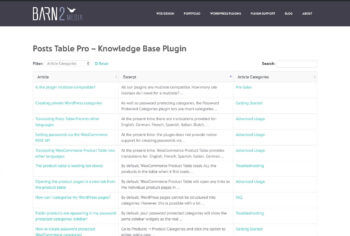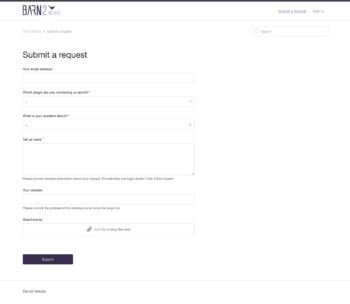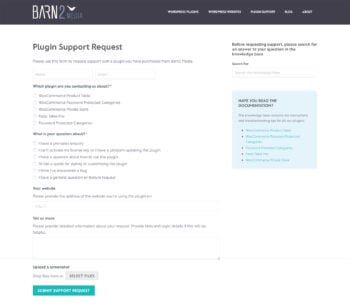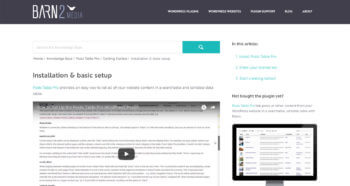The ultimate WordPress documentation & knowledge base plugin
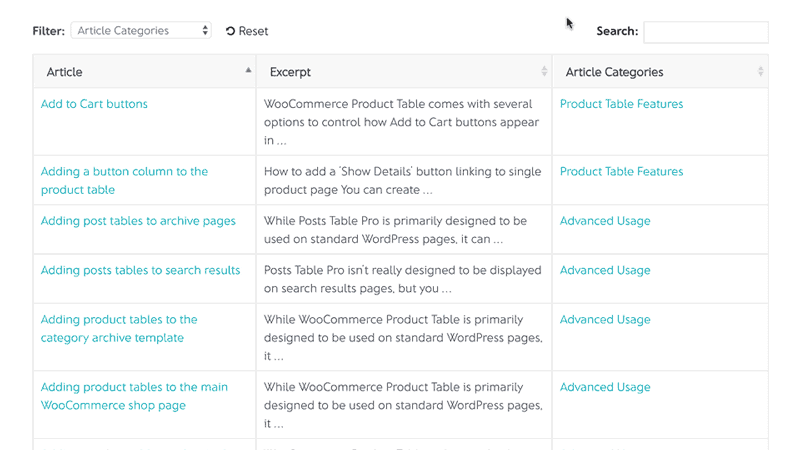
A WordPress knowledge base plugin is the perfect way to provide online documentation for your customers.
In this tutorial, I'll explain why the Posts Table Pro table plugin is ideal for this purpose. You'll learn why it's better than 3rd party knowledge base platforms. I'll even show you how to set it up, from start to finish. You don't need any technical expertise or knowhow and you don't need to write any code. Simple!
In this article
- Do I need a knowledge base or online documentation?
- Should I use a 3rd party help center platform
- But which WordPress knowledge base plugin to use?
- How to use Posts Table Pro as a WordPress knowledge base plugin
- How to hide your knowledge base from public view
Do I need a knowledge base or online documentation?
Before we start, it's worth considering whether you need a WordPress knowledge base plugin at all. As a general rule, you should provide online documentation for your customers if:
- You sell products (whether online or physical) that require instructions.
- Customers regularly ask questions about how to use your products.
- You find yourself answering the same question more than once.
- You'd like to reduce the burden of customer support.
If you've answered 'Yes' to 1 or more of these questions, then a WordPress knowledge base or documentation plugin could be just what you need.
Should I use a 3rd party help center platform such as Zendesk?
When I first researched knowledge base solutions for our own WordPress plugins, I assumed that I'd need something outside of our company website. I couldn't have been more wrong. I'll explain why.
The reason I was seeking a 3rd party solution was that a website can be slowed down by too many free plugins. I do it if there's a valid business case for incorporating a function into our website. However, I believe that some things should be kept outside of your WordPress website. For example, customer invoicing, CRM and accounting have no place on your main company website.
I originally thought that our WordPress plugin knowledge base would fall into this category. We trialed some 3rd party help desk solutions such as the ones from Zendesk and Help Scout. Lots of other WordPress plugin companies (e.g. WP Engine) use these help desk systems for their support ticketing, so why shouldn't we?!
So, we set up a draft knowledge base with each of these companies. We tweaked the colors and images to suit our brand. We set up the knowledge base structure and added lots of articles. Finally, we set up the built-in customer support request form.
Unfortunately, we weren't satisfied with any of these 3rd party help centers. They all had the same drawbacks:
Inconsistent branding
While you can tweak the colors and header images on the hosted knowledge base platforms, they didn't truly match our main website. For example, the fonts and overall look and feel were different. Sure, they looked clean and modern. But the user experience was disjointed as you switched between the two.
You can pay more for further customization options and the ability to add custom CSS. However, these elements are already in place on our main website. Styling a 3rd party knowledge base to match our main website felt like reinventing the wheel. And frankly, a waste of time.
Harder to find articles
I had expected that a dedicated help center platform has more features than a WordPress knowledge base plugin. However, all the ones we tested were lacking in basic functionality. The options for searching the documentation were very basic, making it hard for customers to find the needed articles.
For example:
- There was no option to sort articles by name, topic, etc.
- There were no filter options.
- The articles could only be categorized by a single level of category. As a long-time WordPress user, I'm used to being able to structure information into more complex hierarchies. For example, I wanted to create a top-level category for each of our WordPress plugins, divided into 2 levels of sub-categories. Strangely, this wasn't possible with the hosted solutions we tested.
Inferior support request forms
The 'Request Support' form was incredibly basic. You could add custom fields, but nothing more dynamic. Our support request form is sophisticated and collects different data depending on the customer's answers to each question.
For example, if a customer selects the 'Bug report' option then they're prompted for their login details so that we can investigate. This is a great way to get the information we need, while only displaying fields that are relevant to each customer. It was a shame to be forced to lose all this.
More expensive
As with any hosted solution, you have to pay a monthly fee for a 3rd party knowledge base. It comes free if you use their support ticketing system too. However, we provide personal customer support via email and don't want to hide behind support tickets.
Less good for SEO
With external knowledge base platforms, your documentation will either be on a subdomain of your main domain (e.g. support.barn2.com) or a different domain (e.g. barn2.zendesk.com). If you set your WordPress knowledge base to the public (which you should do!) then it can be crawled and indexed by search engines. However, its rankings will be separate from your main website.
We've spent years building a good search engine ranking for our WordPress website. It seemed a shame to have to start again with the knowledge base.
Incorporating a knowledge base into your WordPress site gives you the best of both worlds:
- Your main WordPress site benefits from the huge amount of SEO-friendly content in your documentation and knowledge base. This can potentially improve Google search results.
- The WordPress knowledge base articles benefit from the wider authority of your main domain name, so they're more likely to get good rankings.
- With a WordPress knowledge base plugin, you get full control over your SEO data. For example, if you use a WordPress SEO plugin then you can add custom title tags, descriptions, etc. Just like you can with the rest of your website!
You don't own your data
Another downside of hosted platforms is that you don't own your own data. Everything is lost if the company goes out of business.
You get more control by hosting a knowledge base on your own WordPress website. Ideally, you should also take regular off-site backups to be doubly secure.
No integration between the knowledge base & support system
 When I send a support request on WooCommerce.com, it automatically searches the knowledge base and suggests articles. It forces me to confirm the articles aren't relevant before I can send a support request. This is a great way of encouraging customers to self-serve and reduce support tickets!
When I send a support request on WooCommerce.com, it automatically searches the knowledge base and suggests articles. It forces me to confirm the articles aren't relevant before I can send a support request. This is a great way of encouraging customers to self-serve and reduce support tickets!
I know that WooCommerce uses Zendesk for its support tickets, so I assumed that this feature was available. On trialing Zendesk, I discovered that this is only possible via custom API integration. That puts this feature out of reach for most people.
To date, I haven't found ANY off-the-shelf solution to auto-search the documentation before you can request support. Instead, I recommend structuring your knowledge base and documentation to make it really easy for customers to self-serve. Make the link to request support less prominent and put it below the list of articles.
Using a WordPress knowledge base plugin gives you more flexibility to do this. Whereas a 3rd party knowledge base puts the support link right at the top, so customers use it without thinking.
Your knowledge base should be part of your website!
By using a WordPress documentation plugin, you can instantly overcome a lot of the drawbacks listed above. Your knowledge base will be part of your WordPress website and not an afterthought.
Everything will integrate seamlessly, boosting your SEO and providing a much better customer experience.
But which WordPress knowledge base plugin to use?

Surprisingly, the plugin I'd recommend for your documentation isn't a dedicated knowledge base plugin! It's a WordPress table plugin - Posts Table Pro.
Posts Table Pro is popular for displaying information in a wide range of ways. For example, it's one of the most popular AJAX based WordPress document library plugins. Following the steps later in this tutorial also provides the perfect knowledge base for any WordPress website.
It automatically lists your knowledge base articles in an interactive table layout. The table gives your customers more ways to find the information they need, compared to typical knowledge-base plugins.
Behind the scenes, you can either use normal WordPress posts for your knowledge-base articles. Or you can create a dedicated custom post type for your articles (my recommendation). Adding a WordPress knowledge base article is as easy as creating a new blog post – no technical know-how required!
Why is Posts Table Pro so great for online documentation?
Easy-to-find articles
There are multiple ways to navigate the WordPress knowledge base, so people can choose the method that suits them. For example:
- The table plugin can list all your articles, with columns for categories, tags, and even custom taxonomies. Customers can filter by category, tag, or custom taxonomy to narrow down the list.
- Alternatively, you can divide the knowledge base into categories and display the articles from each category in different parts of your site. Since your knowledge base articles will be WordPress posts (or custom posts), you can create hierarchical categories with multiple levels. You can either list everything on a single page, with a separate table for each category. Or, you can spread your WordPress knowledge base across multiple pages - each listing different articles. It's hugely flexible and you can structure your knowledge base as you would structure any WordPress website or blog. But with the added benefit of searchable, sortable tables listing your documentation articles.
- There's a keyword search box above the list of knowledge-base articles. Customers can use this AJAX search to find exactly what they're looking for.
- Customers can sort by any column by clicking on it. You don't get this feature with any dedicated WordPress knowledge base plugin.
- You can display filter dropdowns above the table to let customers refine the list of articles. Customers can also refine the list by clicking on a category, tag, or taxonomy term. It's AJAX based which means customers won't have to refresh the page to see filtered results.
Everyone works in different ways, so it's good to offer customers a choice.
Easy to make changes
A successful knowledge base should evolve constantly. Whenever a customer requests support, you should think about why they had to ask the question. Consider how you could improve the knowledge base to prevent people from asking the same thing in the future.
As a result, you're likely to be making constant changes to your WordPress knowledge base. Especially in the first few months.
With Posts Table Pro, your documentation is added as a series of posts that you can easily add and edit via the WordPress admin. If you're a website owner like me, then you're probably logged into the WordPress admin most of the time anyway. It's ridiculously easy to tweak a WordPress knowledge base while you're dealing with support requests. This is much better time management than adding changes to a long 'To Do' list and hoping you find the time in the future!
Once you've updated your knowledge base content, the tables listing the articles will automatically update in the front end. You don't need to do this manually.
You get all the benefits and flexibility of WordPress
Since your knowledge base articles are essentially WordPress 'posts', you can benefit from all the fantastic features that WordPress has to offer. There's no learning curve because you already know how to use WordPress. You can do everything you're used to, such as:
- Use the full WordPress editor - with all the usual formatting options, Add Media button, and extra features added by other plugins. For example, we added a standard WordPress gallery to our knowledge base article about lazy load. The gallery contains 2 animated gifs showing how the plugin works with and without lazy load. You couldn't do this with most knowledge base programs.
- Display global content from other parts of your website, such as the header, footer and widgets.
- Integrate with other features, such as live chat and contact form plugins. (We use Gravity Forms for our customer support requests.)
- Works with knowledge base WordPress themes.
Enhance your documentation with embedded video
 Posts Table Pro supports embedded video players. This is a great opportunity to improve your online documentation.
Posts Table Pro supports embedded video players. This is a great opportunity to improve your online documentation.
Create a video for all your main documentation topics. You can add them to the individual articles. Or even better, you can display the videos directly on the list of articles.
Customers can watch short videos which answer their questions directly from the main WordPress knowledge base page. They don't even need to click through to read the full article!
How to use Posts Table Pro as a WordPress knowledge base plugin
By now, you've discovered the benefits of having a knowledge base as part of your main website. You've also seen why Posts Table Pro is ideal as a WordPress knowledge base plugin. Now, I'll show you how to set it up!
Prerequisites
Before you can do this tutorial, you will need these things. If you don't have them yet, get them before you start:
- A WordPress website.
- The Posts Table Pro plugin, is installed according to the instructions from your order confirmation email.
- A knowledge base theme for WordPress.
That's all!
1. Create a WordPress 'knowledge base' custom post type
First, you need to create the basic infrastructure for your knowledge base content and documentation. If you're feeling lazy, you can use normal WordPress posts for this. This is fine if you're not using posts for anything else. Even if you're using posts for your blog, you can create some dedicated knowledge base categories within Posts → Categories.
However, for most WordPress knowledge bases, I would recommend creating a dedicated post type. This will give you a proper section for your documentation on the left of the WordPress admin. It keeps everything neat and easy behind the scenes. Much more future-proof for you, especially as your knowledge base grows.
There are several ways to create a custom post type in WordPress. If you're a developer, then you can do this programmatically. If not, here is a free and easy-to-use plugin:
You can use this plugin to create custom post types, custom fields, and custom taxonomies. Some knowledge base themes come with custom post types out of the box.
How to create a custom post type
Here are instructions for creating a WordPress knowledge base post type using Easy Post Types and Fields plugin. You can call it anything you like, e.g. Knowledge Base, Articles, Documentation, etc. I think 'Articles' works well for both the singular and plural versions.

- Install and activate the free Easy Post Types and Fields plugin from WordPress.org.
- Go to Post Type → Manage in your WordPress dashboard.
- Click Add New.
- Once the setup wizard loads, enter the singular and plural post type names. For example:
- Plural name – e.g. Articles
- Singular name – e.g. Article
- Click on the Next button.
- Select the type of information you need for the Article post type. Click on the Create button.
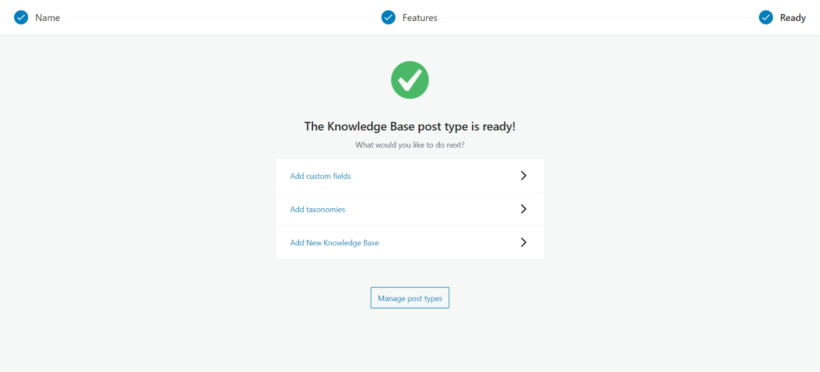
Now, you will see a link to your WordPress knowledge base post type on the left of the dashboard.
2. Create knowledge base categories
Next, you need to plan the structure for your WordPress knowledge base plugin or online documentation. For this, you need to add a custom taxonomy to your post type.
To add a custom taxonomy, go to Post Type → Manage. Click on the taxonomies button for the respective post type you wish to customize (Here, Knowledge Base). On the Manage taxonomies page, click on the Add New button.
Enter the singular and plural names and the slug for your new taxonomy.
If you want your categories to be in hierarchical order, tick the checkbox. Enabling this will allow you to structure your content on multiple levels.
Once you are done, click on the Create taxonomy button.
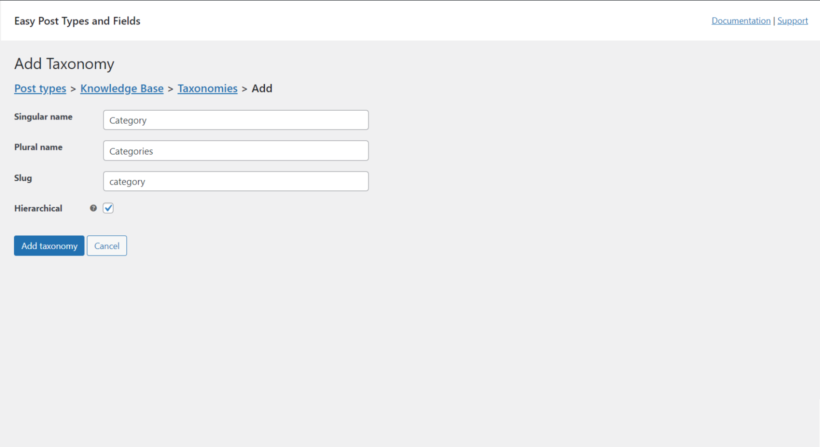
Once you have created the taxonomy, hover over the knowledge base section on the left of the WordPress admin, and click the 'Categories' link. The name might be different if you named your taxonomy differently.
Add as many categories as you like. This can be a simple list of categories, or you can create hierarchical categories with sub-categories, sub-sub-categories, and so on. As with WordPress posts, there are no limits here!
The important thing is to think logically about the best knowledge base structure. Try to think from your customer's perspective. You want to make it as easy as possible for them to find the article they need. Otherwise, they're more likely to contact you for the support! So don't rush this bit.
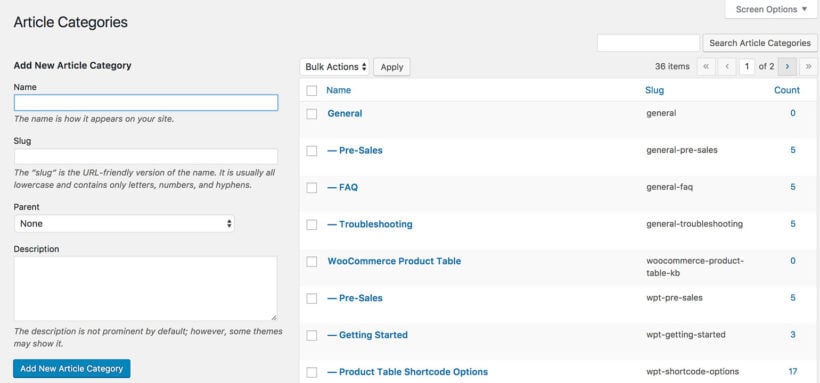
Tip: Make a note of the category slug as you create them. You'll need these later if you're planning to create tables listing articles from specific categories.
3. Add articles, documentation, and FAQ's to your WordPress knowledge base
This is the most time-consuming part of creating a knowledge base. It's time to add the actual content to your online documentation.
To do this, hover over the knowledge base link (or whatever you decided to call it) on the left of the WordPress admin. Click the 'Add New' link that appears underneath. The 'Add New' page is just like the screen for adding normal WordPress posts. You can add a title, the main content, categories, tags, etc.
If you're migrating written instructions or a single page of documentation to your knowledge base, break it down into multiple articles. Categories and tag each article to make them easy to find.
The good news is that you don't have to do this all in one go. To launch your WordPress knowledge base, you just need to provide the basic information for customers to use the product. Over time, you can add more and more articles and provide more extensive documentation.
A knowledge base should be flexible and constantly evolving. This means that you shouldn't worry too much about perfecting it straight away.
Tip #1 - Structure long articles with a knowledge base table of contents
Knowledge base articles can often get quite long, divided up by multiple subheadings. If this applies to you, I'd recommend installing Table of Contents Plus.
This free WordPress plugin lets you create instant lists of all the headings in your knowledge-base article. You can either add the list to the top of the article or as a sidebar widget.
You can see a knowledge base table of contents in the screenshot above. The 'In this article widget was created automatically and lists the headings from the article. It's a great way for customers to quickly find the section that will answer their questions.
Tip #2 - Add a widget promoting your product
Most people aim their knowledge base at their existing customers. This can lead to missed opportunities to attract new customers.
Your documentation is published on your public website, so it's available for the world to see. Potential customers might be searching the web for a specific solution, and find a specific knowledge base article without having any background knowledge about your product. Therefore, every page of your knowledge base should contain some basic information about your product and how they can get it.
Did you spot the "Not bought the plugin yet?" sidebar widget in the screenshot above? Here it is again.
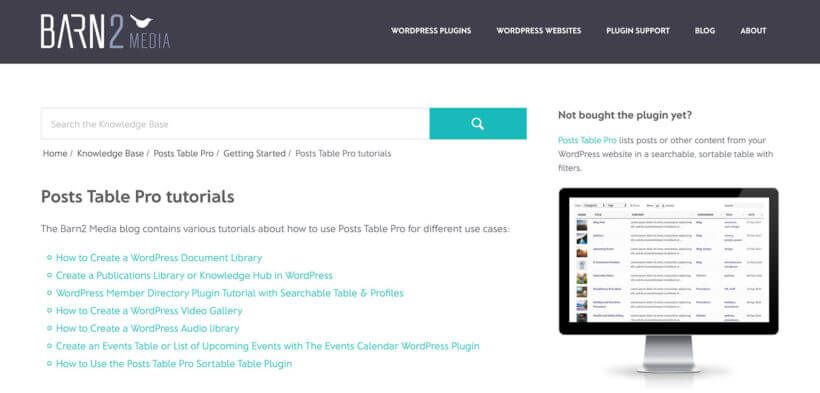
The widget doesn't dominate the page for existing customers but puts the article in context for potential customers. Entering a website directly in a knowledge base article can be confusing as you don't know what you're reading about. This simple widget provides an overview of the plugin that the article relates to, with a subtle call to action. The image of the product in action will attract people who are looking for the solution you're offering.
Tip - Display different widgets in different parts of the knowledge base
You can use the Widget Options plugin to show the relevant widget in the appropriate knowledge base category. That way, you can showcase different products in different sections of the WordPress knowledge base. Whichever product the article is about, customers always see the widget for the correct product.
Tip #3 - Create a WordPress wiki where users can edit your documentation in the front end
If you need a collaborative knowledge base, then transform your documentation into a wiki! You can use a WordPress front end editor plugin to let your users make changes to your knowledge base articles.
Here is another example of a WordPress wiki plugin with front-end editing.
The way it will work is that the Posts Table Pro plugin will automatically list your documentation articles in a table layout. Users will click through to the single article page. From there, they can click 'Edit' to edit the article content. Their changes will automatically appear in the table and on the single article page.
5. Display your knowledge base content in interactive tables
By now, the overall infrastructure for your online documentation is in place. The only remaining task is to display the articles in an easy-to-find format on your public-facing website. We'll do this by using Posts Table Pro as your WordPress knowledge base plugin.
- If you haven't already done so, buy posts Table Pro. Check your order confirmation email and find the link to download the plugin.
- Download the zip file and save it on your computer.
- Access your WordPress admin dashboard and navigate to Plugins → Add New → Upload Plugin.
- Click on "Choose File" and select the zip file you just downloaded.
- Click "Upload" and wait for the plugin to finish uploading, then click "Activate".
- After activation, the Posts Table Pro setup wizard will automatically open and guide you through entering your license key.
6. Configure your knowledge base tables
Upon installing the plugin for the first time, a setup wizard will automatically open up, guiding you through a step-by-step process to create your first table. This process will allow you to customize your table's appearance. You can also create new tables any time by navigating to Post Tables → Add New.
- To begin creating your table, you'll need to provide a name for it and select the post type that you want to display. In this case, you would want to choose the custom post type "articles".
- After that, you can choose the posts or pages that you wish to include in the table. The plugin allows you to choose from a range of options, including posts, pages, and custom post types.
- Once you have selected the content to include in your table, you can proceed to customize its appearance. The plugin offers a wide range of customization options, allowing you to determine which columns to display and in what order. includes columns for name, content, categories and tags. You can include lots of other columns in the table. This includes featured image, excerpt, date, author, custom fields, custom taxonomies, and much more. If you want to add a new column, you can choose the column type from the dropdown menu and click "Add."
- To make it easy for your users to find what they're looking for, you can add filters to your table. For your table, you can use article categories and tags as filters.
- Additionally, you can customize the sorting options for your table, selecting the default sorting option and the sort direction that you prefer. This gives you complete control over the order in which your table is displayed.
- If you're dealing with a large amount of data, you can enable lazy loading to improve the table's performance. This ensures that even when your table contains hundreds or thousands of items, it loads quickly and smoothly.
- Lastly, you can choose how to sort your table, setting the default sorting option and the sort direction that you prefer. With all these options, you can create a table that is functional, easy to use, and visually appealing to your users.
Once you’re done, your knowledge base table should look something like this:

Displaying your knowledge base tables
After successfully creating your table using the Post Table Pro plugin, the setup wizard will confirm that you've completed the process and provide clear instructions on how to insert the table onto your WordPress site. The plugin offers different options for adding the table to your site, depending on your preference.
You can use the "Post Table" block in the Gutenberg editor to add the table directly to your page. Alternatively, you can copy the shortcode from the table builder and paste it onto any page on your site. This provides you with the flexibility to place the table wherever you want, regardless of the content on the page.
If you're creating a knowledge base and want to list all your articles on one page, you can go to Pages → Add New and create the main homepage for your knowledge base. This page will serve as the hub for all your articles, making it easy for your users to find what they're looking for. However, if you prefer to list different articles on different pages, you can create as many pages as you like and customize each page's content to suit the articles you're featuring.
Overall, the Post Table Pro plugin makes it easy to create functional and visually appealing tables that are easy to integrate into your WordPress site. With the flexibility to customize and place the table anywhere you want, you can create an organized and user-friendly experience for your audience.
7. Enable customers to request support
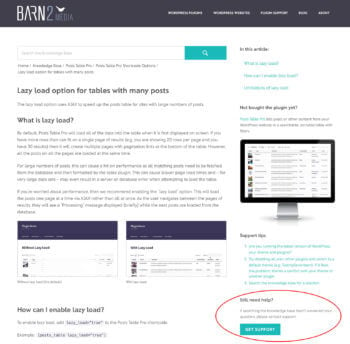 However useful your knowledge base is, customers will still need to contact you for support. Getting this right is a delicate balance. On the one hand, customers should be able to contact you when they need to. On the other hand, you'll benefit from gently encouraging them to help themselves where this is realistic.
However useful your knowledge base is, customers will still need to contact you for support. Getting this right is a delicate balance. On the one hand, customers should be able to contact you when they need to. On the other hand, you'll benefit from gently encouraging them to help themselves where this is realistic.
You can achieve this by making your documentation user-friendly, easy to navigate, and easily searchable. Using Posts Table Pro as your WordPress knowledge base plugin will help with this. This will help customers to self-serve and find answers themselves.
Choose a suitable support platform
Think of the best way for customers to contact you for support. This might be a live chat plugin on your website. It might be a phone helpline. Or it might be a support request form, created using a contact forms plugin such as Gravity Forms or Contact Form 7. This might send you an email, or it might feed into a full ticketing system. You can integrate any of these options with your WordPress knowledge base.
Whichever option you choose, make it accessible to your customers without being too easy. I know it sounds harsh, but making it too easy encourages them to be lazy. Research suggests that most customers self-service, as this is quicker than contacting you and waiting for a response.
Place the 'Request Support' links AFTER your knowledge base articles and search results. Customers should have to search for a solution and look through the articles. They should only contact your support team if this process fails. Don't shoot yourself in the foot by making the support link too obvious!
8. Create a hidden, password-protected WordPress knowledge base
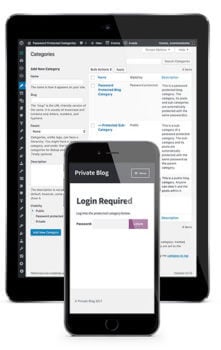 Finally, I'll provide some tips on how to hide your knowledge base from the public view. This is useful if your knowledge base is part of your main website, but you want to restrict the documentation to existing customers only.
Finally, I'll provide some tips on how to hide your knowledge base from the public view. This is useful if your knowledge base is part of your main website, but you want to restrict the documentation to existing customers only.
The Password Protected Categories WordPress plugin hides your knowledge base and documentation. Simply install this simple plugin, create a main category for your knowledge base, and select the 'Password protected' option. You can then add 1 or more passwords - customers must enter a correct password to access the restricted knowledge base.
Your password-protected WordPress knowledge base category can have as many sub-categories as you like. They'll automatically be protected with the same password as the primary parent category. They will be completely hidden from the public parts of your website.
After that, it's up to you how to share access to the knowledge base. You could include the password in the order confirmation email or include it with your product. Or you could use a plugin such as Contact Form 7 to add a 'Request access' form to your website. People can submit the form, and provide evidence of their purchase, and you can then send them the password. Either way, this is a simple way to hide and protect your WordPress knowledge base.
It's time to create your own WordPress knowledge base!
Using the best WordPress knowledge base plugin can make a huge difference to customer satisfaction AND your bottom line.
Remember - the easier it is for customers to find answers to your questions, the less likely customers are to request support. They'll be happier, more likely to recommend your products, and more likely to buy from you again. This frees you up to build your business rather than spending all your time on customer support.
So, now you can get started and create your own WordPress knowledge base with the Posts Table Pro plugin. Set it up and make life easier for customers and you at the same time. And if you like the plugin, become a Barn2 affiliate and earn a 30% commission for recommending it!
I'd love to hear how you get on with your knowledge base plugin. Please leave your comments below.

